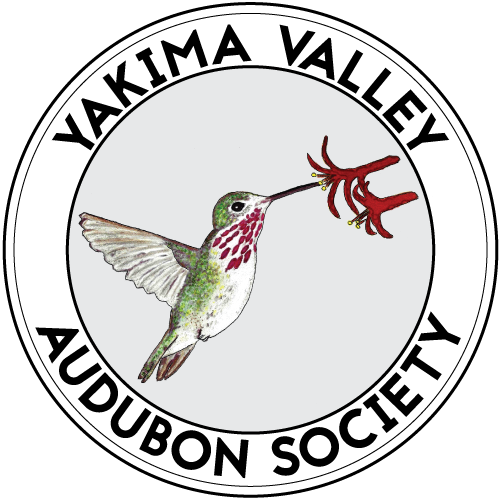Yakima Area Wildlife Viewing Guide
The Yakima area is great for viewing wildlife. Why?
The Cascade Mountains to the west cause a rain shadow. Many habitats occur, from near-desert conditions in the low elevation shrub-steppe upwards through dry Ponderosa Pine and Douglas-fir woodlands, then wetter forests similar to those of the “wetside,” and finally glacier-mantled peaks astride the Cascade crest. Sample the great variety of wildlife of the Yakima region by visiting the following numbered sites or select the specific region.
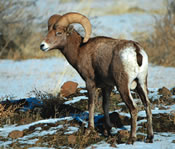
- Yakima Town and Surrounding Area
- White Pass Highway (US-12)
- Chinook Pass Highway (SR-410)
- Wenas Creek and Lower Valley
Download Yakima Area Wildlife Viewing Guide Brochure (PDF)
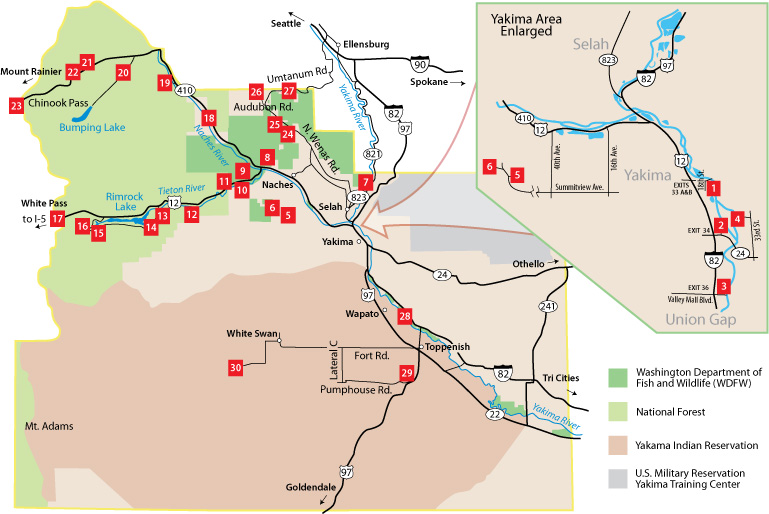
Icons suggest the best seasons for a visit to each site.
 Spring
Spring Summer
Summer Fall
Fall Winter
Winter All Seasons
All Seasons
Yakima Town and Surrounding Area
Yakima Area Greenway and the Yakima Area Arboretum are great places to spot birds and stretch your legs. This paved pathway straddles a 9-mile stretch of the Yakima River between Selah and Union Gaps. Expect Great Blue Heron, Canada Goose, Common Merganser, Downy Woodpecker, Northern Flicker, Bewick’s Wren, Black-capped Chickadee, and Song Sparrow at any season. Summer visitors include flycatchers, swallows, warblers, and orioles. In winter, Bald Eagles hunt for fish from their cottonwood perches, while Common Goldeneyes float the river. There are three accesses from I-82:
Yakima Town Area
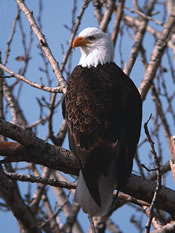
1. Sarg Hubbard Park 
From Exit 33. East on Terrace Heights Boulevard 0.3 mile to 18th Street. Right to the entrance. Walk either north or south from here. South takes you to a marsh and then past Buchanan Lake to Sherman Park.
2. Sherman Park 
From Exit 34. East 0.2 mile, then left. Walk either north or south. The Yakima Area Arboretum interpretive center is a short distance past the Sherman Park parking lot. Hawthorn plantings are attractive to waxwings, robins, and Varied Thrushes in winter. A variety of sparrows lurk around feeders in the riparian area east of the hawthorn plantings in winter.
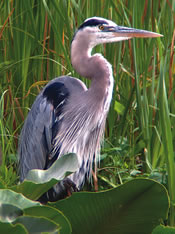
3. Helen Jewett Pathway 
From Exit 36. East to parking. Two trails start from here: the paved Jewett Pathway and the gravel Poppoff Nature Trail. Both are good for birds. Look for Wood Ducks in the ponds. Berries of the Russian-olive trees are attractive to American Robin, Cedar Waxwing, and European Starling in winter. Beaver, Muskrat, and Mule Deer are common here.
Yakima Surrounding Area
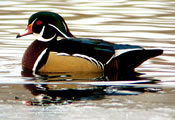
4. Sportsman State Park 
Take Exit 34 from I-82. 1.2 mile east to 33rd St. Left here 1 mile to the entrance on your left. The pond is a good bet at any season for Wood Ducks. Great Blue Herons and Belted Kingfishers fish the river and sloughs. Look for Downy Woodpecker, Black-billed Magpie, Black-capped Chickadee, and Bewick’s Wren in the trees and brush. Western Screech-Owl and Great Horned Owl are night denizens of the tall cottonwood trees.
5. Cowiche Canyon 
Walk a 3-mile long path set in a rugged canyon just west of Yakima. Take Summitview Avenue west from 40th Avenue 7 miles to Weikel Road. Right 0.1 mile to the parking area turnoff. Walk downstream along Cowiche Creek, flanked by lush riparian vegetation. Turkey Vulture, Red-tailed Hawk, American Kestrel, Canyon Wren, Yellow-breasted Chat, and Bullock’s Oriole are common here. August and September bring large numbers of Cedar Waxwings, Black-headed Grosbeaks, and robins, plucking the many berries from the streamside vegetation. Yellow-bellied Marmots whistle from the rocks in spring. Watch out for rattlesnakes.
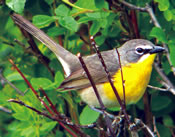
6. Snow Mountain Ranch 


Cowiche Mountain is protected in this 1700-acre preserve, great for hikers. Take Summitview Avenue west from 40th Avenue 9 miles, then left on Cowiche Mill Road 2.5 miles to signed parking. Take the trail from here across the creek to fields and up Cowiche Mountain. Along Cowiche Creek’s riparian zone, look for Lewis’s Woodpecker, Yellow-breasted Chat, and Bullock’s Oriole. Brushy areas have Ash-throated Flycatcher and Lazuli Bunting. Higher, shrub-steppe habitats host Sage Thrasher, and Brewer’s and Vesper Sparrows.
7. Yakima Canyon 
Take Exit 26 from I-82 and go north on SR-821. Great Blue Herons may be seen on the west side of I-82 south of Exit 26. View this rookery from Harrison Road off the exit. Continue north into the canyon. Suggested stops from I-82 are at 3.3 miles (raptors), then another 0.5 mile (raptors, Chukar), and then another 8.1 miles (geological exhibit). Scan the cliffs and talus slopes for Bighorn Sheep and Mule Deer along this beautiful route. Bald Eagles are numerous in winter. In spring and summer, look for Golden Eagle, Red-tailed Hawk, and Prairie Falcon. Chukar and Canyon Wren are common near cliffs and Eastern Kingbird, Yellow-breasted Chat, and Bullock’s Oriole flit in the riparian vegetation along the river. Beyond the geological exhibit nearly 4 miles, turn left into Umtanum Creek Recreation Area (fee), the best site in the canyon. Cross the suspension bridge to hike upstream along the creek to search for all the species mentioned above in a beautiful setting. Keep alert for rattlesnakes in warm months.
8. Bighorn Sheep Feeding Station 

At the junction with US-12 and SR-410, go north on Old Naches Road 0.1 mile to a canal and park. In spring the trees along the canal can be swarming with migrants, including Yellow-breasted Chat, warblers, and Lazuli Bunting. Another 0.5 mile along this road is a WDFW parking area on the left. Scan the steep slopes of Cleman Mountain for a band of Bighorn Sheep. Look for Golden and Bald Eagles, Chukar, and Rock Wren.
White Pass Highway (US-12)
White Pass Highway (US-12) is a year-round route across the Cascades from shrub-steppe upwards through dry forest habitats to lower subalpine wet habitats. Lakes, marshes, and rivers along the way provide habitat for water and riparian zone birds, too.
Make stops at:
9. Oak Creek Wildlife Area 
West on US-12 from SR-410 2 miles to headquarters for this wildlife area. A huge Rocky Mountain Elk herd is fed daily here in winter, usually at 1:30 pm. Oaks and cottonwoods here attract Lewis’s Woodpecker and Bullock’s Oriole during the warmer months. Golden Eagle and Canyon Wren occupy the cliffs south of the highway, reached by a bridge across the Tieton River opposite the feeding station entrance.
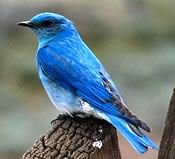
10. Tieton River Nature Trail 

West on US-12 another 1.2 mile is parking for this trail. WDFW permit required. Follow the path across a field to a suspension bridge over the Tieton River. Riparian vegetation, brushy hillsides, and cliffs along the way attract many birds, including Golden Eagle, Lewis’s Woodpecker, and Bullock’s Oriole.
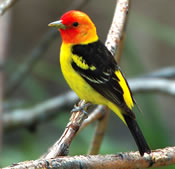
11. Bear Canyon 

West on US-12 another 3.5 miles. Walk uphill from gate into oak and scattered conifers in a scenic canyon protected by The Nature Conservancy. Forest areas have Steller’s Jay, House Wren, and Nashville Warbler. The cliffs attract Golden Eagle, White-throated Swift, Violet-green Swallow, and Canyon Wren.
12. Rimrock Retreat 

West on US-12 another 5.9 miles, watch Calliope and Rufous Hummingbirds war over feeders from the Trout Lodge dining room.
13. Tieton Road (Forest Road 1200) 


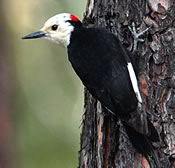
Go left off US-12 5 miles from Trout Lodge. Road loops around the south side of Rimrock Lake to Clear Lake and rejoins US-12 about 7 miles east of White Pass. In May and June, a wide variety of breeding species can be found in the forests, meadows, and marshes along this route. Following forest roads a short distance from the paved road can lead to many interesting areas.
14. Peninsula Campground (fee) 


Turnoff is 2.9 miles along Tieton Road. The aspen grove and Ponderosa Pine forest has many birds, including Red-naped Sapsucker.
15. Clear Lake Campground South (fee) 


Clear Lake Campground South (fee) is 8.6 miles farther west on Tieton Road. Forest and water birds. Nearby creek below Clear Lake Dam has swarms of spawning Kokanee Salmon, a landlocked species, in September. Watch for American Dipper, too.
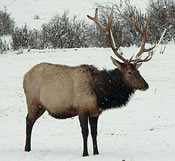
18. Clear Lake Day Use Site (fee) 


Clear Lake Day Use Site (fee) is another mile along Tieton Road, keep right once across the North Fork, staying on this road. In 0.6 mile, turn right. A paved 1-mile path takes you to vantages of Clear Lake. Look for Barrow’s Goldeneye, Ring-necked Duck, and Osprey. Patches of alder and willows have Swainson’s Thrush, vireos, and warblers (MacGillivray’s and Yellow). The conifer forest should produce Hammond’s Flycatcher, Western Wood-Pewee, Chestnut-backed Chickadee, Yellow-rumped and Townsend’s Warblers, and Western Tanager. Reach US 12 in another 2.5 miles. Turn left.
17. Dog Lake Campground 
Dog Lake Campground (fee), in 5.5 miles and White Pass Campground (fee), another 1.5 miles, are good for mountain species. Forests, meadows, and lakes at high elevation (4500 feet) offer Ring-necked Duck, Barrow’s Goldeneye, and Osprey, Red-naped and Williamson’s Sapsuckers, Gray Jay, Clark’s Nutcracker, Chestnut-backed Chickadee, Winter Wren, Hermit and Varied Thrushes, White-crowned Sparrow, and Pine Siskin. Listen for Barred Owls in the dense forests behind Leech Lake.
Chinook Pass Highway (SR-410)
Chinook Pass Highway (SR-410) is a summer-only route across the Cascades. Explore the forest roads, paved side roads and campgrounds for a variety of bird species.
Make stops at:
18. The Nile Road 

In 12 miles west from US-12, turn left onto (upper) Nile Road. In a few hundred yards, stop and check wetland by the road for Willow Flycatcher, Gray Catbird, and Yellow Warbler.
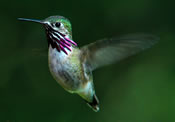
19. Boulder Cave 

Continuing on SR-410, turn left to Boulder Cave in 9 miles to sample riparian habitat by the Naches River. Look for Harlequin Duck and Dipper. The cave is a hibernacula for Townsend’s Bats.
20. Bumping River Road 

West along SR-410 7 miles, turn left onto Bumping River Road, passing beautiful forest to Bumping Lake, a reservoir with nesting Barrow’s Goldeneye and Osprey.
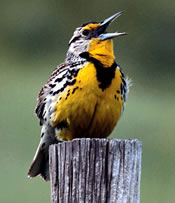
21. Fife’s Peak Viewpoint 
Fife’s Peak Viewpoint in another 7 miles along SR-410 is good for spying Mountain Goats. (A scope is useful here.)
22. Pleasant Valley Campground 

1.3 miles west on SR-410. Check for Chinook Salmon in the river in August. Look to the sky for Black and Vaux’s Swifts.
23. Chinook Pass 

In 12 miles reach Chinook Pass. At 5432 feet elevation, this parkland is a riot of color in July and August when the subalpine meadows bloom. Magnificent views of Mt. Rainier. Morning light is best. Listen and look for whistling Hoary Marmots and browsing Mule Deer. Scan the peaks for Mountain Goats. Birds include Blue Grouse, Gray Jay, Clark’s Nutcracker, Mountain Chickadee, Hermit and Varied Thrush, Fox Sparrow, and Cassin’s Finch. Rufous Hummingbird, many warblers, and sparrows occur in fall in brushy patches.
Wenas Creek and Lower Valley
Wenas Creek Region, along the lower east slopes of the Cascades, is good for a variety of breeding birds, best in spring and early summer. A variety of habitats, including shrub-steppe, riparian, ponderosa pine woodland, mixed-conifer, and subalpine forests, makes this whole region attractive to many species of breeding birds. Take Exit 26 from I-82 and go north on SR-821 0.1 mile to Harrison Road. Go left here to North Wenas Road, then go right.
Make stops at:
24. Wenas Lake 


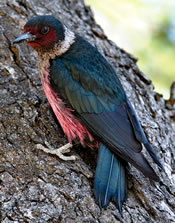
Access is at the WDFW ‘Fishing Access’ parking area on the west side (inlet) of the lake. Great Blue Heron, ducks, and Osprey are expected here. Lower water levels expose a wide area of mud by late July or August. Look for shorebirds at this time. Look for both species of yellowlegs, Solitary, Semipalmated, Western, and Least Sandpipers, Long-billed Dowitcher, Red-necked Phalarope, and Wilson’s Snipe. Mud boots are helpful. Walk the riparian area upstream from the lake along a sketchy trail. Look for Eastern Kingbird, swallows, Gray Catbird, Yellow Warbler, Black-headed Grosbeak, Lazuli Bunting, and Bullock’s Oriole.
25. Hardy Canyon 


Up the North Wenas Road another 1.5 miles is Hardy Canyon in the Oak Creek Wildlife Area. Great for birds of the riparian zone, fields, and shrub-steppe habitats such as Pacific-slope and Ash-throated Flycatchers, Eastern Kingbird, Tree Swallow, Gray Catbird, Warbling Vireo, Nashville and Yellow Warblers, Yellow-breasted Chat, Black-headed Grosbeak, and Lazuli Bunting. Elk and Mule Deer are common. (Open May through Nov.)
26. Audubon Road 


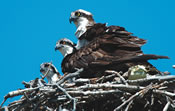
Four miles farther up North Wenas Road. At end of pavement, go left onto Audubon Road. Initially, pass shrub-steppe vegetation composed mainly of Bitterbrush and scattered Ponderosa Pine. Scan from the road; this is private land. In 3 miles, turn left into Wenas Campground, known for its variety of breeding species. Along the road, creek and nearby ponderosa pine woods, check for Red-naped Sapsucker, Downy and White-headed Woodpeckers, Western Wood Pewee, Mountain Chickadee, White-breasted Nuthatch, House Wren, Veery, Warbling Vireo, Nashville, Yellow and MacGillivray’s Warblers, Black-headed Grosbeak, Chipping Sparrow, Cassin’s Finch, and Red Crossbill. Putting out a feeder may attract hummingbirds (Black-chinned, Calliope, and Rufous). South from the campground entrance, go west on a dirt track along the South Fork of Wenas Creek. In 1/3 mile, check the brushy hillside to the south for Calliope Hummingbird, Dusky Flycatcher, and Nashville Warbler. At Hog Ranch Road, hike right on a rough track to a bench where White-headed Woodpecker, Gray Flycatcher, Pygmy Nuthatch, and Cassin’s Finch occur. (Open May through Nov.)
27. Umtanum Road 


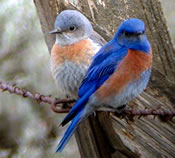
From the pavement end, continue north on North Wenas Road (gravel). Open Ponderosa Pine forests have Gray Flycatcher, particularly beyond Ellensburg Pass, reached in 4 miles. Look for White-headed Woodpecker, and Western and Mountain Bluebirds. The shrub-steppe habitat to the east of the pine forest hosts Horned Lark, Sage Thrasher, Brewer’s and Vesper Sparrow, and Loggerhead Shrike. The Yakima Valley Audubon Society has a trail of bluebird boxes with nesting Western and Mountain Bluebirds along the road. From near Box 71, take a trail 1 mile to Umtanum Falls.
28. I-82 



Traveling I-82, a number of Osprey nests can be seen on power poles adjacent to freeway ponds from Selah to Granger. Look for these fish-eating hawks from late March through September.
29. Toppenish NWR 
Toppenish NWR, with fields, riparian areas, and ponds hosts many birds. Spring is best when Toppenish Creek floods. Winter is good for raptors. From US-97/SR-22 junction in Toppenish, go south 5.5 miles on US-97.
A loop tour can start at viewing platform just off US-97 at the refuge entrance with views of the marsh and ponds. Look for waterfowl and shorebirds from this platform. Eastern Kingbird and Gray Catbird reside in the brush by the creek. The trees around the headquarters building 1/3 mile to the west have Great Horned Owl. From the platform go west on Pumphouse Road to Old Goldendale Road. The marsh along this road has American Bittern in the warmer months, as well as Virginia Rail, Sora, Marsh Wren, and Common Yellowthroat. Go back to Pumphouse Road, turn right, then north on Lateral C. Bird the wooded area at Toppenish Creek, then continue north, looking for Bobolink that nest in the fields on both sides of Lateral C. Long-billed Curlew and Yellow-headed Blackbird are also along this road. Continue north on Lateral C to Fort Road. A right turn will take you back to Toppenish. A left turn will take you to:
30. Fort Simcoe State Park 


20 miles west of Toppenish on Fort Road. Picnic under the beautiful Garry Oaks and watch for Lewis’s Woodpecker, White-breasted Nuthatch, and Steller’s Jay. Ash-throated Flycatchers nest where brushy patches meet oaks. Spring and fall migration is also very good.
(Graphic Design: Kathryn Q. Blair)
